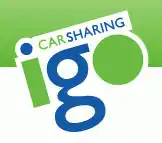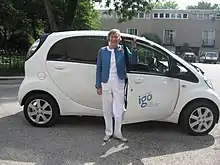 | |
| Type | Not-for-profit |
|---|---|
| Industry | Car rental |
| Founded | 2002 in Chicago, Illinois |
| Founder | Center for Neighborhood Technology |
| Defunct | May 2013 |
| Fate | Sold to Enterprise Holdings |
| Successor | Enterprise CarShare |
| Headquarters | , United States |
Area served | Chicago, Illinois |
| Services | Carsharing |
| Owner | Enterprise Holdings |
| Website | www |
I-GO was a Chicago-based car sharing organization which is owned by Enterprise Holdings. It was established in 2002 by the Center for Neighborhood Technology as an independent 501(c)(3) not-for-profit organization working in the fields of urban livability and sustainability. I-GO was sold to Enterprise Holdings in May 2013 and re-branded as Enterprise CarShare.[1]
History
- 2001: I-GO is created by the Center for Neighborhood Technology as the first car sharing organization in the Chicago market.
- 2002: I-GO begins operations as a pilot project with six cars.
- April 2005: I-GO begins its suburban expansion, placing cars in Evanston, Illinois.
- August 2008: I-GO and eight other leading non-profit and independent North American car sharing organizations adopt a code of ethics to specify standards and strengthen the industry.
- October 2008: I-GO membership reaches 10,000.
- January 2009: I-GO establishes a joint smart card with the Chicago Transit Authority, allowing I-GO members to access CTA buses and trains using a single card.
- April 2009: Two plug-in hybrid electric vehicles are added to I-GO fleet; the joint effort between I-GO and ComEd is formally recognized by Governor Quinn.
- May 2013: I-GO is sold to Enterprise Holdings in order to expand.[2]
Stated mission
I-GO’s stated mission was to reduce car ownership rates, decrease transportation costs, reduce urban congestion, and improve air quality in Chicago. It focuses on a convenient and economic way to commute without having to own a car and to reduce vehicle miles travelled and greenhouse gas emissions.[3]
Operations
I-GO had cars located in approximately 30 Chicago neighborhoods. I-GO members reserved a vehicle online or by calling its customer service. Members could also create and modify their reservations using smartphones. Once a reservation had been created, the member accesses the reserved car using a member card. As of June 2009, I-GO had more than 12,000 members and 185 cars available for use.
The average fuel efficiency of I-GO's fleet was 35 miles per gallon, and the fleet was composed of low-emission vehicles. Approximately 40% of the fleet were hybrid vehicles and plug-in hybrid electric vehicles.
Plug-in hybrid electric vehicles

I-GO added the first two plug-in hybrid electric vehicles to its fleet of vehicles in April 2009 as a result of a joint effort with electricity provider ComEd.
Partnerships
I-GO had strategic partnerships and alliances with government offices, local businesses, as well as other non-profits and independent car sharing organizations. Among others, I-GO worked closely with the Chicago Transit Authority, City of Chicago and Chicago Park District. Businesses such as Whole Foods and Dominick's provided parking spaces dedicated to I-GO cars, and I-GO also worked with universities, including Northwestern University, University of Chicago, Loyola University Chicago, DePaul University, University of Illinois at Chicago and Illinois Institute of Technology.
See also
References
- ↑ Badger, Emily (May 29, 2013). "What Happens When a Nonprofit Car-Sharing Service Gets Bought By a Major Rental Company?". Archived from the original on March 10, 2014. Retrieved 2023-02-20.
- ↑ Wernau, Julie (2013-05-28). "Enterprise buying Chicago's I-Go car service". Chicago Tribune. Retrieved 2013-07-20.
- ↑ "About us : I-GO Car Sharing". Igocars.org. Archived from the original on 2010-11-25. Retrieved 2010-11-27.